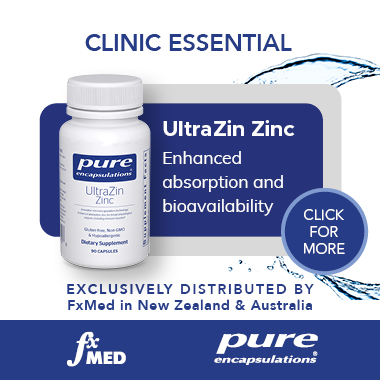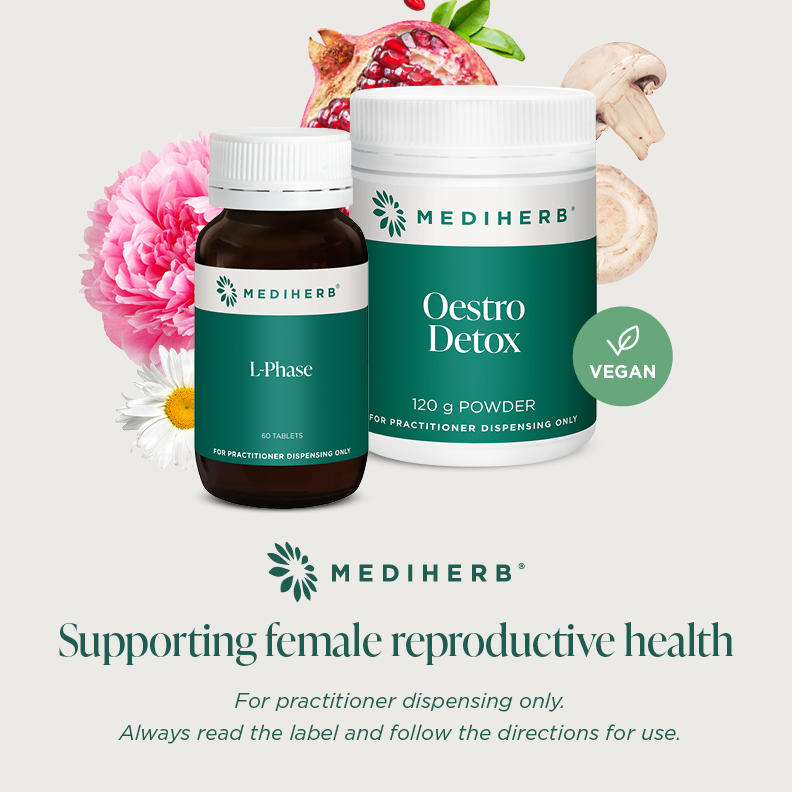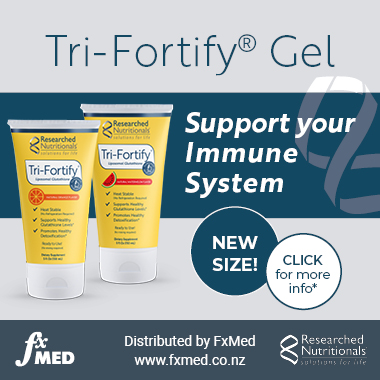Volume 34 Issue 3
Editorial
Susan Arentz
For referencing Arentz S. Editorial. The Australian Journal of Herbal and Naturopathic Medicine 2022;34(3):96-98
DOI https://doi.org/10.33235/ajhnm.34.3.96-98
Whether it’s called long COVID, post-COVID‑19 syndrome or long-haul COVID‑19, it is shaping up as one of the looming public health crises to emerge from the pandemic, and focus is now turning to its longer lasting effects on people, and the anticipated healthcare needs. Between 41–53% of people are reported to experience ongoing symptoms after an acute infection1,2. SARS-CoV‑2 has been found to be multisystemic. In addition to respiratory illness, it can heighten disease risk in people with pre-existing conditions, including neurological3, renal4,5 and cardiac diseases6,7, as well as trigger autoimmune diseases. Furthermore, in otherwise healthy individuals, acute symptoms such as fatigue, pain and brain fog, that are difficult to quantify, can become chronic and cause long-term psychological and emotional impacts8,9. To minimise personal risk, people appear to be using health boosting and preventative measures to an unprecedented extent10.
The increased uptake of complementary medicines in Australia in 2021 represented a doubling in size over the past couple of years, with more than 73% of Australians purchasing at least one complementary medicine during the past year11. Although data are scant, it stands to reason that there has also been an increase in consults with naturopaths and herbalists, as people seek preventative and (perceived) low-risk treatments. So how do naturopaths and herbalists approach their care of people with lingering symptoms from COVID‑19?
Although long COVID disease mechanisms are poorly understood, they are thought to be at least partly mediated by chronic inflammation12. This is the rationale for treatment with nutritional supplements and herbal medicines with anti-inflammatory properties, such as Curcuma longa (turmeric) and N-Acetyl-L-cysteine (NAC), both with demonstrated anti-inflammatory effects through inhibition of pro-inflammatory mediators13,14. From an evidence-based naturopathic and herbalist perspective, these remedies make sense, especially when supported by published evidence. There are, however, other mechanisms at play in long COVID, such as persistent (intracellular) viral infection, genetic alterations, maladaptive healing and tissue damage that cause organ dysfunction in various body systems and auto immune responses similar to rheumatoid arthritis, Lupus erythematosus and anticardiolipin and Sjogren syndrome12,15. Missing these pathological mechanisms, whilst focussing on certain anti-inflammatory markers, could be a crucial mistake in determining effective and safe treatment. In addition, clinical decisions based on disease mechanisms is only one small part of evidence-based practice, and a primary focus on inflammatory markers, especially in complex ‘unknown cause’ types of illness, is the epitome of reductionist management. There is plenty of perfectly placed reductionist healthcare already, with arguably better targeted anti-inflammatory treatments.
The essential value of naturopaths and herbalists in long COVID lies in their knowledge, skill and expertise to map complex conditions in individuals against natural interventions that touch all aspects of the disease. Complex interventions consist of multiple bioactive parts with multiple simultaneous effects. It is an approach that starts with knowledge about the person and the way they experience the disorder, respect for their present resources and susceptibilities, an understanding of typical pathology, as well as knowledge about interventions in terms of the way they work, as well as efficacy as reported by patients receiving clinical care for the same condition. And there is already suggestion that it works.
In a retrospective analyses of 30 people with mild to moderate COVID‑19 who received treatment by naturopaths of dietary interventions (bone broth, greens and beetroot), nutritional supplements, herbal medicines and probiotics, none went on to develop long COVID, despite many being at high risk from pre-existing conditions16. Some of the simultaneous effects included absorption of building blocks for optimal health, stimulating self-healing internal processes, restoring weakened systems, and symptom relief in addition to specific anti-inflammatories. For herbal medicine formulations, 100 people with long COVID, randomised to take either a proprietary blend of Rhodiola, Eleutherococcus and Schisandra, or placebo, significantly more of the group taking herbal medicine reported less fatigue and pain without any adverse effects after only 2 weeks17. In this case, interestingly, there were virtually no changes to inflammatory cytokines, which means that laboratory evidence of broad anti-inflammatory effects for each herbal medicine18–20 were not demonstrated in people with long COVID. This randomised control trial (RCT) showed that although herbal adaptogens were effective at reducing fatigue and pain in long COVID, the therapeutic mechanisms were not clear. In other words, it worked, but we don’t know how. Although this research direction, where therapies are tested in people who are unwell before knowing the exact mechanism of effect, might seem irrational, it is the best strategy available for mitigating the urgent public health crisis of long COVID21.
Treatment approaches have developed from researchers working closely with patient advocacy groups putting together the most frequent clinical characteristics, signs and symptoms and, from there, working towards potential interventions15. Evidence-based clinical practice guidelines emphasise the importance of multidisciplinary rehabilitation teams, determined by the needs of individuals21. Unfortunately, in Australia, the role of naturopaths and herbalists is often overlooked. In India, naturopathy is being embraced. Over 50,000 acute COVID patients, including 15,000 in hospital, received formal adjunct naturopathy as a component of multidisciplinary healthcare in the Indian state of Tamil Nadu22. Although it may be a coincidence, Tamil Nadu was shown to have one of the fastest recovery rates (7 days, 95% CI 5.7 to 7.9) in India23. Furthermore, the prevalence of long COVID in high risk hospitalised individuals in Chennai (Tamil Nadu), where uptake of adjunct naturopathy was highest, was only 2–6%24. This is one of the lowest prevalence rates of long COVID in the world. It begs the question ‘does adjunct naturopathy lower the risk of long COVID in hospitalised people with SARS-COV‑2?’ A positive answer to this question would support the inclusion of naturopaths and herbalists in multidisciplinary healthcare teams treating people with acute and subsequently long COVID.
This issue of the journal includes evidence-based clinical practice guidelines for managing people with long COVID as they stand at present. These guidelines, put together by the national COVID‑19 clinical evidence taskforce, evolve as evidence becomes available. Following this is a comprehensive commentary of naturopathy and where it sits in relation to the wellness industry. It highlights our marginalisation in an industry where we should really be at front and centre.
Next there are two case reports. The first is of integrated naturopathy and yoga showing reduced fatigue, the primary presenting complaint, and improved quality of life in a woman with breast cancer. The second is a case of metabolic alkalosis caused by Spanish lavender tea in a male with benign prostatic hyperplasia. The patient presented at hospital outpatients. Following cessation of the tea, all biochemical parameters normalised.
Finally, we present a RCT demonstrating efficacy for a traditional Iranian medicine in the management of blood glucose in people with type 2 diabetes. The authors provide several photos showing their harvesting and preparation of the herbal medicine. When you look at the photos you can’t help but recognise the incidental benefits in the use of the traditional herbal medicine – the connection to the earth, physical activity, exposure to UV light and earth microbiota, and the social benefits of working together – benefits that sit outside of the chemical composition of the herbal medicine. If there is a panacea medicine, it would involve this kind of activity that engages physical, intellectual and emotional energy and has whole benefits for individuals (in this case with with type 2 diabetes), the community, the environment and the soul.
Dr Wendy McLean has again put together an edifying MedJourn and MedHerb section. Reviewed publications include two for herbal medicines for treatment of COVID‑19, silymarin and the herbal adaptogens discussed above. Enjoy.
Author(s)
Susan Arentz PhD, BHSc(Hons)
Editor, Australian Journal of Herbal and Naturopathic Medicine
PO Box 696, Ashfield, NSW 2131, Australia
Email editor.ajhnm@nhaa.org.au
References
- Naik S, Haldar SN, Soneja M, et al. Post COVID‑19 sequelae: a prospective observational study from Northern India. Drug Discoveries &Therapeutics 2021.
- Reyes Domingo F, Waddell LA, Cheung AM, et al. Prevalence of long-term effects in individuals diagnosed with COVID‑19: an updated living systematic review. MedRxiv 2021.
- Munhoz RP, Pedroso JL, Nascimento FA, et al. Neurological complications in patients with SARS-CoV‑2 infection: a systematic review. Arquivos de Neuro-Psiquiatria 2020;78:290–300.
- Han L, Zhao S, Cao W, Javanbakht M, Ran J, Sun S. Changes in renal failure mortality during the COVID‑19 pandemic in the United States. Journal of Nephrology 2021;34:2167–70.
- Khoshdel-Rad N, Zahmatkesh E, Shpichka A, Timashev P, Vosough M. Outbreak of chronic renal failure: will this be a delayed heritage of COVID‑19? Journal of Nephrology 2021;34(1):3–5.
- Rowe SL, Leder K, Dyson K, Sundaresan L, Wollersheim D, Lynch BM, Abdullahi I, Cowie BC, Stephens N, Nolan T, Sullivan S, Sutton B and Cheng AC. Complications following SARS-CoV‑2 infection in Victoria, Australia: a record linkage study. Pre-print SSRN 2022.
- Kochi AN, Tagliari AP, Forleo GB, Fassini GM, Tondo C. Cardiac and arrhythmic complications in patients with COVID‐19. Journal of Cardiovascular Electrophysiology 2020;31:1003–8.
- Kamal M, Abo Omirah M, Hussein A, Saeed H. Assessment and characterisation of post‐COVID‐19 manifestations. International Journal of Clinical Practice 2021;75:e13746.
- Santomauro DF, Herrera AMM, Shadid J, et al. Global prevalence and burden of depressive and anxiety disorders in 204 countries and territories in 2020 due to the COVID‑19 pandemic. The Lancet 2021;398:1700–12.
- Complementary Medicines Australia. Australia’s Complementary Medicines Industry Audit & Trends 2021: healthy growth [cited 2022 May 16]. Available from: https://www.cmaustralia.org.au/page-1859595
- Statista. Share of consumers who purchase complementary medicines in Australia in 2021; 2022. Available from: https://www.statista.com/statistics/1285506/australia-leading-complementary-medicines-purchased/#statisticContainer
- Yong SJ. Long COVID or post-COVID‑19 syndrome: putative pathophysiology, risk factors, and treatments. Infectious Diseases 2021;53:737–54.
- Memarzia A, Khazdair MR, Behrouz S, et al. Experimental and clinical reports on anti‐inflammatory, antioxidant, and immunomodulatory effects of Curcuma longa and curcumin, an updated and comprehensive review. BioFactors 2021;47:311–50.
- De Flora S, Balansky R, La Maestra S. Rationale for the use of N‐acetylcysteine in both prevention and adjuvant therapy of COVID‐19. The FASEB Journal 2020;34:13185–93.
- Nalbandian A, Sehgal K, Gupta A, et al. Post-acute COVID‑19 syndrome. Nature Medicine 2021;27:601–15.
- Barber MS, Barrett R, Bradley RD, Walker E. A naturopathic treatment approach for mild and moderate COVID‑19: a retrospective chart review. Complementary Therapies in Medicine 2021;63:102788.
- Karosanidze I, Kiladze U, Kirtadze N, et al. Efficacy of adaptogens in patients with long COVID‑19: a randomized, quadruple-blind, placebo-controlled trial. Pharmaceuticals 2022;15:345.
- Yang D-W, Kang O-H, Lee Y-S, et al. Anti-inflammatory effect of salidroside on phorbol-12-myristate-13-acetate plus A23187-mediated inflammation in HMC-1 cells. International Journal of Molecular Medicine 2016;38:1864–70.
- Jin L, Schmiech M, El Gaafary M, Zhang X, Syrovets T, Simmet T. A comparative study on root and bark extracts of Eleutherococcus senticosus and their effects on human macrophages. Phytomedicine 2020;68:153181.
- Oh S-Y, Kim YH, Bae DS, et al. Anti-inflammatory effects of gomisin N, gomisin J, and schisandrin C isolated from the fruit of Schisandra chinensis. Bioscience, Biotechnology, and Biochemistry 2010;74:285–91.
- National COVID-19 Clinical Evidence Taskforce. Care of people with post COVID‑19, version 4.1; 2022. Available from: https://covid19evidence.net.au/wp-content/uploads/flowchart-11-care-of-people-with-post-covid19-v4.1.pdf?=220509-14214
- Prabu T, Subramanian KK, Manavalan N, Venkateswaran S, Maheshkumar K. An approach towards COVID‑19 pandemic with yoga and naturopathy interventions – Tamilnadu model. Clinical Epidemiology and Global Health 2021;12.
- George N, Tyagi NK, Prasad JB. COVID‑19 pandemic and its average recovery time in Indian states. Clinical Epidemiology and Global Health 2021;11:100740.
- Rubeshkumar P, John A, Narnaware M, et al. Persistent post COVID‑19 symptoms and functional status after 12–14 weeks of recovery, Tamil Nadu, India, 2021. Journal of Infection 2022;84:722–46.






